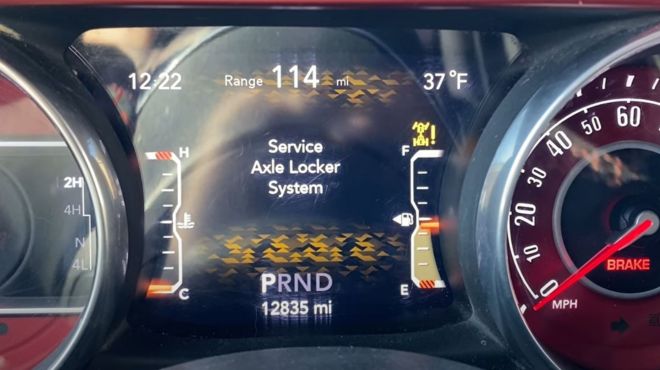Service Axle Locker System warning is a common error message that can pop up related to the axle locker. This indicates there is some kind of problem with the locker system that requires attention. Potential causes range from fluid contamination issues to wiring damage to mechanical failures.
The main trigger for the “Service Axle Locker System” error is typically failure of the sensor that monitors the locker’s engagement status. However, faults in the wiring, connectors, control module electronics, or even software bugs can also at times manifest with the same warning message that something is amiss in the locker activation system.

An axle locker system is an important feature in off-road vehicles that allows both wheels on one axle to rotate at the same speed. This locks the two wheels together and significantly improves traction and stability when driving over rough or slippery terrain. Without a properly functioning locker system, wheels can spin independently and cause you to lose momentum or get stuck.
This issue is mostly prevalent on Jeep Wrangler Rubicon models from 2018 to newer and Jeep Gladiator models from 2020 to newer versions.
The goal of this article is to take a deeper look at the axle locker system, explore some of the common triggers for the “Service Axle Locker System” error message, and provide solutions drivers can use to address locker problems. Properly diagnosing and fixing any problems is key to restoring full off-road capabilities.
Common Causes of the Service Axle Locker System Error
There are a few typical culprits that can trigger the annoying “Service Axle Locker System” warning message.
Sensor Malfunctions
One root cause is when the locker system’s sensors get filled with differential gear oil or other fluids, causing them to malfunction. The locker relies on electronic sensors to monitor conditions and activate/deactivate the system when needed. If the protective seals around the sensors fail, differential gear oil can leak past the seal. As the sensor fills up with oil, metallic bits from the gears often also contaminate it. This can interfere with the delicate electronics and cause sensor failure errors. Replacing damaged sensors is the fix here.
Fluid Leaks into Wiring Harness
Another fluid-related issue is when oil manages to leak into the wiring harness leading to the locker electronics. Typical points of failure here are transmission fluid plugs that become loose or worn over time. As oil seeps from the plugs, it follows wiring bundles back to the locker control modules. This can cause shorts or corrosion in the wiring that disrupts proper operation and triggers error messages. Addressing leaky plugs and seals, along with replacing any damaged wires, is key to resolving these types of problems.
Damaged/Loose Internal Wiring
Another set of common causes stem from issues with the axle locker mechanism’s internal wiring harnesses. Some possibilities include:
Chafed, Broken, or Corroded Wires: The wiring for the locker system faces exposure to water, debris, and vibration which can eventually cause fraying or breaks in the wires. Corrosion can build up causing conductivity problems. These damaged wires then disrupt signals to the locker control module and as a result service axle locker system warning pops up on your Jeep dashboard screen.
Bad Electrical Connections
Vibration and debris can also cause the wiring harness connectors to come loose or fail to make solid contact. Intermittent electrical connectivity will confuse the locker controller.
Manufacturing Defects
Sometimes wiring issues come from the factory itself. Improperly crimped connectors, poor quality wire shielding, or minor deficits in insulation can become failure points down the road leading to electrical disruption.
Software or Control Module Issues
The brains of the locker operation also sometimes malfunction. Buggy control software, faulty inputs, or a completely dead control module can activate error messages. Often modules need firmware updates or resets when they get scrambled electrically.
Careful inspection and electrical troubleshooting are key to diagnosing and addressing axle locker electronics issues stemming from bad wiring and connections.
Also, there are complaints regarding that this issue is caused due to PCM software update
Overuse/Abusive Driving
The axle locker components also fall victim to physical damage from excessive use and aggressive driving. Excessive off-road strain or leaving the locker activated on firm ground leads to rapid wear. And the wiring is vulnerable to ripping and shorting from the harsh forces vehicles face when tackling extreme terrain, which also triggers system errors.
Blown Fuse
Like any electrical system, the locker relies on fuses to protect its circuits from current spikes. When drivers excessively “pump” the locker on and off through rough sections, it can lead to fuse blowing failures. Constant fuse replacement is a clue that the user may need more training on proper operation.
Mechanical Problems
The locker has several mechanical pieces like the locking dog gears that engage/disengage the wheel hubs. These components face immense stresses with hard off-road use. Over time the mechanical pieces can wear, bend or break leading to activation failures. Issues like stripped engagement teeth often require locker rebuilds or replacements.
While the locker system is built for rugged use, drivers still need proper operation skills and judgement to avoid damaging it through overly frequent or harsh use. Training, practice and conservative locker deployment are the best way to avoid abusing and prematurely wearing down axle locker hardware.
Also see – Service Shifter Jeep Warning: Causes and Fixes
How to Fix the Service Axle Locker System Warning
Now that we’ve explored some of the typical factors that can cause axle locker problems, here are some solutions for each:
Sensor Replacement
If locker sensors are contaminated and damaged by fluid infiltration, they will need to be replaced. Technicians will disconnect the sensors, thoroughly clean the housing, install new sealed sensors, and test operation.
Addressing Fluid Leaks
For issues caused by leaking transmission plugs or seals, the source of the leak must be addressed. Damaged plugs, worn seals and gaskets should be replaced. Care should be taken to thoroughly clean wiring harnesses contaminated by fluid leaks to prevent ongoing issues.
Electrical Repairs
For chafed wiring or bad connections, damaged sections will need splicing and replacement. Connectors must be carefully inspected, cleaned and reseated. Close examination of wiring routing may reveal unnecessary wear points to mitigate going forward.
Software Updates
Where control modules are generating errors, updated firmware can often restore proper function. Factory recall campaigns commonly address locker electronics issues through flash updates.
With some diligent diagnosis and the appropriate solution for the root cause, you can get rid of the service axle locker system error and restore the default system operation. But careful operation and maintenance are equally key to avoiding recurring issues down the road.
Some Tips to Extend the Lifespan of the Locker System Include:
- Routinely inspect wiring condition with emphasis on wear points
- Address any fluid leaks promptly to prevent contamination
- Change differential gear oil per factory intervals
- Avoid excessive locker cycling/engagement
- Have the system periodically diagnosed even without errors to check for impending problems before they strand you on the trail!
Following the automaker’s maintenance recommendations and operating the locker judiciously can go a long way toward avoiding issues out on the rugged trails.
Also see – Service Electronic Throttle Control Jeep Warning: How to Fix?
Can You Drive With the Locker Light On?
It’s possible to safely drive with the “Service Axle Locker System” warning light activated for short distances if needed to exit a remote area and get to a repair shop. However, the locker system will likely be disabled with the light on, limiting traction capability. Any underlying electrical, sensor or mechanical problems can worsen without attention. So it’s imperative to get the codes scanned and have a technician properly diagnose the specific issue for repair as soon as reasonably possible.
Conclusion
To wrap up, axle lockers are invaluable for traversing rugged terrain, but face electrical and mechanical failure risks from fluid and wiring damage. Paying attention to leak points, wire routing, and responsible operation can help avoid becoming stranded far from help. Periodically checking locker electronics health even without warnings turned on can nip problems before they leave you frozen on a challenging climb. And understanding the diagnostic steps and typical repair needs arms you to get back motoring over the rocks or desert sands. With some diligence to address problems promptly, your locker system can support many more adventures in your capable 4X4.
For those needing help decoding Service Axle Locker System issues, experienced off-road shop technicians with scanner tools and wiring diagrams are best equipped to accurately troubleshoot problems and prescribe the needed repairs. Investing some care into your locker system pays big dividends when your next epic trek leads through miles of tough terrain far from civilization. Stay safe out there!
Also Read:



